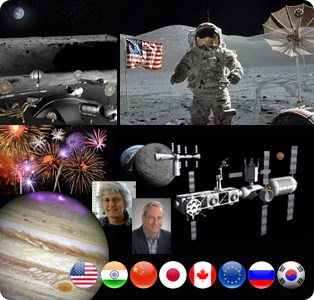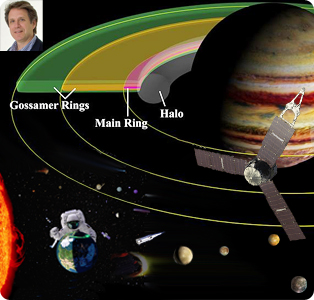2017 USA Space Program and the Moon, Apollo@50, Juno@Jupiter – Galaxy Forum USA Inaugurates Spacemonth July 2016
Space Age Publishing Company and International Lunar Observatory Association host Galaxy Forum USA in Santa Clara, California on Saturday July 2, to start the July 4th weekend and Spacemonth 2016. Bruce Pittman, Chief Systems Engineer, NASA Ames will talk about USA Space Program direction in 2017 and future goals in light of 2019 Apollo 11 50th Observation. A Jupiter presentation by Professor Imke de Pater of UC Berkeley Astronomy Department celebrates NASA Juno spacecraft arrival. Steve Durst of SPC / ILOA will provide introductions and welcoming remarks, and make the case for putting human Moon missions and Jupiter back into the American space program with consideration for 21st Century Solar System Complete. The incremental, low-cost and low-risk Evolvable Lunar Architecture (ELA) study partly funded by NASA and published July 2015 by Charles Miller of NexGen Space, is designed to leverage commercial space capabilities and public-private-partnerships. It projects America could lead a return of humans to the Moon surface within 5-7 years at an estimated total cost of US$10B (+/-30%) via development of 2 independent competing commercial service providers. This range of projections parallels similarly abbreviated ELA (Early Lunar Access) study by General Dynamics in 1992-93 which projected $5-10B for a 2-3 week human sojourn, additional expeditions about $2B each, further cost savings if ESA were partner. It is clear now, as ever, that a new American initiated program to return humans to the Moon should be both international and commercial, open to participation of India, China, Japan, Canada, Europe, Russia, Korea and others. (Image Credit: NASA, NexGen Space LLC, A. Nesterova, UC Berkeley, FreeFlagIcons.com)
|
MONDAY
|

![]() = All times
= All times
for terrestrial events in local time unless noted.
![]() = All times for international terrestrial events in local time unless noted.
= All times for international terrestrial events in local time unless noted.
![]() = All times for space events, and…
= All times for space events, and…
![]() = All times for international space / astro events in Hawaii Standard Time unless noted. Add 10 hours to obtain UT (‘Universal Time;’ Greenwich, England).
= All times for international space / astro events in Hawaii Standard Time unless noted. Add 10 hours to obtain UT (‘Universal Time;’ Greenwich, England).
Weekly Planet Watch – Evening Planets: Mars (S), Jupiter (W), Saturn (S); Morning Planets: Uranus (E), Neptune (SE).
Juno July 4 Jupiter Arrival May Spark 21st Century Human Jupiter, Solar System Missions
|
Continued from…
|
TUESDAY
![]() NET Jul 5 — CNSA, Launch Long March 2D / Quantum Science Satellite, Jiuquan, China: Long March 2D to launch Quantum Science Satellite, the first mission to test ultra-secure quantum communications in orbit; Physicist Pan Jian-Wei from University of Science and Technology is leading project.
NET Jul 5 — CNSA, Launch Long March 2D / Quantum Science Satellite, Jiuquan, China: Long March 2D to launch Quantum Science Satellite, the first mission to test ultra-secure quantum communications in orbit; Physicist Pan Jian-Wei from University of Science and Technology is leading project.
![]() Jul 5 — Juno, Jupiter Orbit: Capture Orbit phase to begin today, will last 106 days.
Jul 5 — Juno, Jupiter Orbit: Capture Orbit phase to begin today, will last 106 days.
![]() Jul 5 — British Interplanetary Society, London, United Kingdom: Lecture: Protecting Space for Future Generations; Richard Crowther, Chief Engineer at UK Space Agency.
Jul 5 — British Interplanetary Society, London, United Kingdom: Lecture: Protecting Space for Future Generations; Richard Crowther, Chief Engineer at UK Space Agency.
![]() Jul 5 — Moon: 4.3° S of Beehive Cluster, 20:00.
Jul 5 — Moon: 4.3° S of Beehive Cluster, 20:00.
WEDNESDAY
![]() Jul 6/7 — RSA, Launch Soyuz TMA-20M (Soyuz-MS) / ISS 47S, Baikonur Cosmodrome, Kazakhstan: Expedition 48/49 members Anatoli Ivanishin of RSA, Takuya Onishi of JAXA, Kathleen Rubins of NASA to launch to ISS; 21:36 EDT July 6, 07:36 local time July 7.
Jul 6/7 — RSA, Launch Soyuz TMA-20M (Soyuz-MS) / ISS 47S, Baikonur Cosmodrome, Kazakhstan: Expedition 48/49 members Anatoli Ivanishin of RSA, Takuya Onishi of JAXA, Kathleen Rubins of NASA to launch to ISS; 21:36 EDT July 6, 07:36 local time July 7.
![]() Jul 6-8 — Simon Fraser University, Vancouver, British Columbia, Canada: 16th Canadian Conference on General Relativity and Relativistic Astrophysics.
Jul 6-8 — Simon Fraser University, Vancouver, British Columbia, Canada: 16th Canadian Conference on General Relativity and Relativistic Astrophysics.
![]() Jul 6-9 — Space Renaissance International, Lifeboat Foundation, Rome, Italy: Space, Not War! World Congress; Postponed to Mar 2017.
Jul 6-9 — Space Renaissance International, Lifeboat Foundation, Rome, Italy: Space, Not War! World Congress; Postponed to Mar 2017.
![]() Jul 6 — Venus: 5.6° S of Pollux, 14:00.
Jul 6 — Venus: 5.6° S of Pollux, 14:00.
![]() Jul 6 — Mercury: At superior conjunction with Sun, 1.329 AU from Earth, 17:00.
Jul 6 — Mercury: At superior conjunction with Sun, 1.329 AU from Earth, 17:00.
THURSDAY
![]() Jul 7 — Moon: 1.7° SSW of Regulus, 13:00.
Jul 7 — Moon: 1.7° SSW of Regulus, 13:00.
![]() Jul 7 — Apollo Asteroid 2016 MO: Near-Earth flyby (0.017 AU).
Jul 7 — Apollo Asteroid 2016 MO: Near-Earth flyby (0.017 AU).
![]() Jul 7 — Pluto: At opposition, 06:00.
Jul 7 — Pluto: At opposition, 06:00.
FRIDAY
![]() Jul 8 — Lunar and Planetary Institute, Houston TX: Lecture: Micro Cold Traps on the Moon; Paul Hayne of Jet Propulsion Laboratory
Jul 8 — Lunar and Planetary Institute, Houston TX: Lecture: Micro Cold Traps on the Moon; Paul Hayne of Jet Propulsion Laboratory
![]() Jul 8 — The Space Show, Online / Tiburon CA: Dr. David Livingston talks with Joel Green about James Webb Space Telescope.
Jul 8 — The Space Show, Online / Tiburon CA: Dr. David Livingston talks with Joel Green about James Webb Space Telescope.
SATURDAY
![]() Jul 9 — Tucson L5 Society – NSS Chapter, Tucson AZ: Regular monthly meeting of the Tucson L5 Society.
Jul 9 — Tucson L5 Society – NSS Chapter, Tucson AZ: Regular monthly meeting of the Tucson L5 Society.
![]() Jul 9 — Moon: 0.81° SSW of Jupiter, 00:00.
Jul 9 — Moon: 0.81° SSW of Jupiter, 00:00.
![]() Jul 9 — Asteroid 4923 Clarke: Near-Earth flyby (0.719 AU).
Jul 9 — Asteroid 4923 Clarke: Near-Earth flyby (0.719 AU).
![]() Jul 9 — Mercury: 8.5° S of Castor, 04:00.
Jul 9 — Mercury: 8.5° S of Castor, 04:00.
SUNDAY
![]() Jul 10 — Department of Science and Technology of the Philippines, Ministry of Education, Culture, Sports, Science and Technology of Japan (MEXT), JAXA, Online / Manila, Philippines: Applications Due for APRSAF-23 Side Events; to be held Nov 15-18.
Jul 10 — Department of Science and Technology of the Philippines, Ministry of Education, Culture, Sports, Science and Technology of Japan (MEXT), JAXA, Online / Manila, Philippines: Applications Due for APRSAF-23 Side Events; to be held Nov 15-18.
![]() Jul 10-12 — Commonwealth Scientific and Industrial Research Organisation (CSIRO), Curtin University, Perth, Australia: 2016 Australasian Astrobiology Meeting.
Jul 10-12 — Commonwealth Scientific and Industrial Research Organisation (CSIRO), Curtin University, Perth, Australia: 2016 Australasian Astrobiology Meeting.
![]() Jul 10-16 — International Center of Interdisciplinary Science Education, Rencontres du Vietnam, Quy Nhon, Vietnam: 22nd International Symposium on Particles, Strings and Cosmology (PASCOS 2016)/12th Rencontres du Vietnam.
Jul 10-16 — International Center of Interdisciplinary Science Education, Rencontres du Vietnam, Quy Nhon, Vietnam: 22nd International Symposium on Particles, Strings and Cosmology (PASCOS 2016)/12th Rencontres du Vietnam.
![]() Jul 10 — Mercury: 5.0° S of Pollux, 12:00.
Jul 10 — Mercury: 5.0° S of Pollux, 12:00.
![]() Jul 10 — Venus: At perihelion (distance 0.7185 AU from Sun), 16:00.
Jul 10 — Venus: At perihelion (distance 0.7185 AU from Sun), 16:00.

